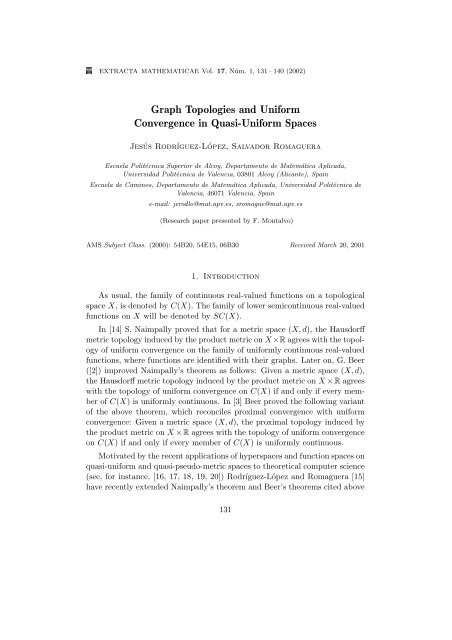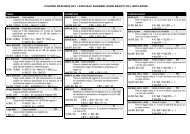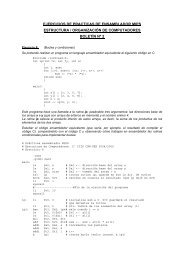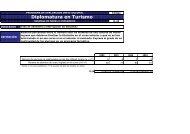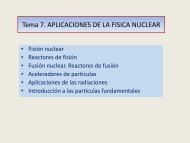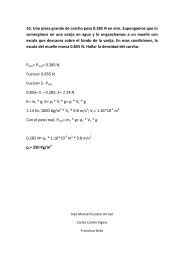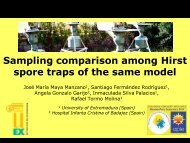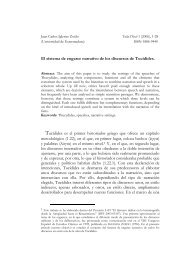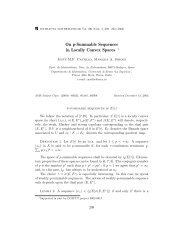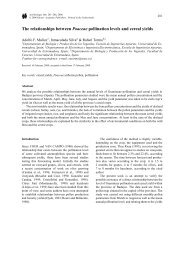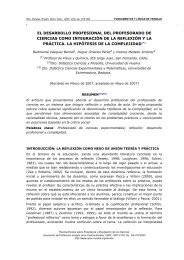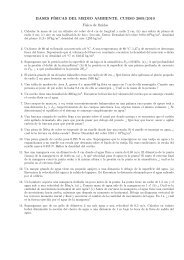Graph Topologies and Uniform Convergence in Quasi-Uniform ...
Graph Topologies and Uniform Convergence in Quasi-Uniform ...
Graph Topologies and Uniform Convergence in Quasi-Uniform ...
Create successful ePaper yourself
Turn your PDF publications into a flip-book with our unique Google optimized e-Paper software.
graph topologies <strong>and</strong> quasi-uniform convergence 133Every quasi-uniformity U on X generates a topology T (U). A neighborhoodbase for each po<strong>in</strong>t x ∈ X is given by {U(x) : U ∈ U} whereU(x) = {y ∈ X : (x, y) ∈ U}.Similarly, the topology generated on a set X by a quasi-pseudo-metric d,is denoted by T (d).In the sequel, we shall denote by l the quasi-pseudo-metric on R def<strong>in</strong>edby l(x, y) = (x − y) ∨ 0 for all x, y ∈ R.For any nonempty set X, we denote by P 0 (X) the family of all nonemptysubsets of X.2. Prelim<strong>in</strong>ariesGiven two quasi-uniform spaces (X, U) <strong>and</strong> (Y, V), a function f from Xto Y is said to be quasi-uniformly cont<strong>in</strong>uous if for every V ∈ V we can f<strong>in</strong>dU ∈ U such that if (x, y) ∈ U then (f(x), f(y)) ∈ V .The set of all quasi-uniformly cont<strong>in</strong>uous functions from X to Y is denotedby UC(X, Y ).Def<strong>in</strong>ition 1. Let (X, U) be a quasi-uniform space.[11], we def<strong>in</strong>eFollow<strong>in</strong>g [5] <strong>and</strong>U + H = {(A, B) ∈ P 0(X) × P 0 (X) : B ⊆ U(A)}U − H = {(A, B) ∈ P 0(X) × P 0 (X) : A ⊆ U −1 (B)}for all U ∈ U. Then {U + H: U ∈ U} is a base for the upper Hausdorff quasiuniformityH + U of U <strong>and</strong> {U − H: U ∈ U} is a base for the lower Hausdorffquasi-uniformity H − U of U. The quasi-uniformity H U def<strong>in</strong>ed as the supremumof the lower <strong>and</strong> upper Hausdorff quasi-uniformities is called the Hausdorffquasi-uniformity of U.Given two quasi-uniform spaces (X, U) <strong>and</strong> (Y, V) we denote by C(X, Y )the family of cont<strong>in</strong>uous functions from (X, T (U)) to (Y, T (V)). If f ∈C(X, Y ) we denote the graph of f by Gr f, i.e. Gr f = {(x, f(x)) : x ∈ X}.On the set C(X, Y ) we consider the upper Hausdorff quasi-uniformityH + U −1 ×V<strong>in</strong>duced by the product quasi-uniformity U −1 × V when we identifyeach cont<strong>in</strong>uous function with its graph. Then, each basic entourageof H + U −1 ×V is of the form (U −1 × V ) + H= {(f, g) ∈ C(X, Y ) × C(X, Y ) :(U × V −1 )(x, g(x)) ∩ Gr f ≠ ∅ for all x ∈ X}, where U ∈ U <strong>and</strong> V ∈ V.
134 j. rodríguez-lópez, s. romagueraSimilarly, the lower Hausdorff quasi-uniformity H − on C(X, Y ) hasU −1 ×Vbasic entourages of the form (U −1 × V ) − H= {(f, g) ∈ C(X, Y ) × C(X, Y ) :(U −1 × V )(x, f(x)) ∩ Gr g ≠ ∅ for all x ∈ X}, where U ∈ U <strong>and</strong> V ∈ V.The Hausdorff quasi-uniformity H U −1 ×V <strong>in</strong>duced on C(X, Y ) by the productquasi-uniformity U −1 × V is the supremum of H + U −1 ×V <strong>and</strong> H− U −1 ×V .Def<strong>in</strong>ition 2. Let (X, U) <strong>and</strong> (Y, V) be two quasi-uniform spaces. Thetopology generated on C(X, Y ) by the sets of the form G − = {f ∈ C(X, Y ) :Gr f ∩ G ≠ ∅} where G is a T (U −1 × V)-open set is called the lower proximaltopology <strong>and</strong> is denoted by T − (δ U −1 ×V).The topology generated on C(X, Y ) by all sets of the form G ++ = {f ∈C(X, Y ) : there exists U ∈ U <strong>and</strong> V ∈ V such that (U −1 × V )(Gr f) ⊆ G}where G is a T (U −1 × V)-open set is called the upper proximal topology <strong>and</strong>is denoted by T + (δ U −1 ×V).The topology T (δ U −1 ×V) = T + (δ U −1 ×V) ∨ T − (δ U −1 ×V) is called the proximaltopology.Let us recall that the proximal topology was essentially <strong>in</strong>troduced <strong>in</strong> [13],although the term “proximal (hit-<strong>and</strong>-miss) topology” was firstly used <strong>in</strong> [4],[6] <strong>and</strong> [12], where the relationship between the proximal topology <strong>and</strong> otherknown hyperspace topologies was studied. In particular, the proximal topologyis compatible with Fisher convergence [7] of sequences of sets, as considered<strong>in</strong> [1].3. The resultsProposition 1. Let (X, U) <strong>and</strong> (Y, V) be two quasi-uniform spaces. ThenT (δ U −1 ×V) = T (H + ) on C(X, Y ).U −1 ×VProof. Let us consider the set G ++ where G is a T (U −1 × V)-open set<strong>and</strong> A ∈ G ++ . Therefore, we can f<strong>in</strong>d U ∈ U <strong>and</strong> V ∈ V such that (U −1 ×V )(A) ⊆ G. Let us consider the set (U −1 × V ) + H(A). It is evident thatA ∈ (U −1 × V ) + H (A) ⊆ G++ .Furthermore, if we have that Gr f ∈ G − where G is a T (U −1 × V)-openset <strong>and</strong> f ∈ C(X, Y ), let (x, f(x)) ∈ Gr f ∩ G. S<strong>in</strong>ce (x, f(x)) ∈ G we canf<strong>in</strong>d U ∈ U <strong>and</strong> V ∈ V verify<strong>in</strong>g (U −1 × V )((x, f(x))) ⊆ G. Let W ∈ V suchthat W 2 ⊆ V . S<strong>in</strong>ce f ∈ C(X, Y ) we can f<strong>in</strong>d U ′ ∈ U such that (f(x), f(y)) ∈W whenever (x, y) ∈ U ′ . We claim that (U ′−1 × W ) + H (Gr f) ⊆ G− . LetGr g ∈ (U ′−1 × W ) + H(Gr f). Therefore, we can f<strong>in</strong>d (y, f(y)) ∈ Gr f such that
graph topologies <strong>and</strong> quasi-uniform convergence 135(x, y) ∈ U ′ <strong>and</strong> (f(y), g(x)) ∈ W . Furthermore, by the above observationwe obta<strong>in</strong> that (f(x), f(y)) ∈ W , so (f(x), g(x)) ∈ W 2 ⊆ V . Consequently,(x, g(x)) ∈ (U −1 × V )(x, f(x)) ⊆ G, i.e. Gr g ∩ G ≠ ∅.For the other <strong>in</strong>clusion, let us consider the set (U −1 × V ) + H(A) whereU ∈ U <strong>and</strong> V ∈ V. It is easy to prove that (<strong>in</strong>t T (U −1 ×V)((U −1 × V )(A))) ++ ⊆(U −1 × V ) + H (A).If (X, U) <strong>and</strong> (Y, V) are two quasi-uniform spaces, the quasi-uniformity ofuniform convergence on C(X, Y ) <strong>in</strong>duced by V is the quasi-uniformity V X onC(X, Y ) whose elements V X are def<strong>in</strong>ed byV X = {(f, g) ∈ C(X, Y ) × C(X, Y ) : (f(x), g(x)) ∈ V for all x ∈ X}.The topology generated by V X is called, simply, the topology of uniformconvergence on C(X, Y ) <strong>and</strong> is denoted by T (V X ).Proposition 2. Let (X, U) <strong>and</strong> (Y, V) be two quasi-uniform spaces. ThenT (H U −1 ×V) ⊆ T (V X ) on C(X, Y ).Proof. Let us suppose that {f λ } λ∈Λ is a net <strong>in</strong> C(X, Y ) which is T (V X )-convergent to f ∈ C(X, Y ). Consider the set (U −1 × V ) H (Gr f) where U ∈ U<strong>and</strong> V ∈ V. Therefore, we can f<strong>in</strong>d λ 0 ∈ Λ such that f λ ∈ V X (f) for allλ ≥ λ 0 . It is evident that Gr f λ ∈ (U −1 × V ) H (Gr f) for all λ ≥ λ 0 .The follow<strong>in</strong>g proposition extends Naimpally’s theorem to the quasiuniformsett<strong>in</strong>g.Proposition 3. Let (X, U) <strong>and</strong> (Y, V) be two quasi-uniform spaces. ThenT (δ U −1 ×V) = T (H + U −1 ×V ) = T (H U −1 ×V) = T (V X ) on UC(X, Y ).Proof. By the above results, we only have to show that T (V X ) ⊆T (H + U −1 ×V ).Let {f λ } λ∈Λ be a net <strong>in</strong> UC(X, Y ) such that it is T (H + U −1 ×V )-convergentto a function f ∈ UC(X, Y ). Fix W ∈ V. Therefore, we can f<strong>in</strong>d U ∈ Usuch that if (x, y) ∈ U then (f(x), f(y)) ∈ W ′ where W ′ ∈ V <strong>and</strong> W ′2 ⊆ W .Furthermore, there exists λ 0 ∈ Λ such that Gr f λ ∈ (U −1 × W ′ ) + H(Gr f) forall λ ≥ λ 0 .Given x ∈ X <strong>and</strong> λ ≥ λ 0 we can f<strong>in</strong>d y ∈ X such that (x, y) ∈ U <strong>and</strong>(f(y), f λ (x)) ∈ W ′ . Therefore, (f(x), f λ (x)) ∈ W ′2 ⊆ W , i.e. f ∈ W X (f λ ) forall λ ≥ λ 0 .
136 j. rodríguez-lópez, s. romagueraNow, we present some examples where we can apply this result.Example 1. As we observed at the <strong>in</strong>troduction, if f : (X, T ) → (Y, T ′ )is a cont<strong>in</strong>uous function <strong>and</strong> U denotes the Perv<strong>in</strong> (resp. po<strong>in</strong>t f<strong>in</strong>ite, locallyf<strong>in</strong>ite, semi-cont<strong>in</strong>uous, f<strong>in</strong>e transitive, f<strong>in</strong>e) quasi-uniformity on X (see [8] forthe correspond<strong>in</strong>g def<strong>in</strong>itions) <strong>and</strong> V the correspond<strong>in</strong>g quasi-uniformity onY then f : (X, U) → (Y, V) is quasi-uniformly cont<strong>in</strong>uous (see [8, Proposition2.17]). Therefore, we deduce that T (H U −1 ×V) = T (V X ) on C(X, Y ).Now, we recall some def<strong>in</strong>itions about the theory of lattices. Our ma<strong>in</strong>reference is [9].A partially ordered set (or a poset) is a nonempty set L with a reflexive,transitive <strong>and</strong> antisymmetric relation ≤. A lattice is a poset where everynonempty f<strong>in</strong>ite subset has <strong>in</strong>fimum <strong>and</strong> supremum.Given a lattice L <strong>and</strong> O ⊆ L, we denote ↑ O = {l ∈ L : there exists o ∈O such that o ≤ l}.A lattice is said to be complete if every nonempty subset has <strong>in</strong>fimum <strong>and</strong>supremum.Let L be a complete lattice. We say that x is way below y, <strong>and</strong> we denoteit by x ≪ y, if for all directed subsets D of L the relation y ≤ sup D impliesthe existence of d ∈ D such that x ≤ d, where D is called directed set if givenp, q ∈ D we can f<strong>in</strong>d l ∈ D such that p ≤ l <strong>and</strong> q ≤ l.A cont<strong>in</strong>uous lattice is a complete lattice L such that it satisfies the axiomof approximation:x = sup{u ∈ L : u ≪ x}for all x ∈ L.Let L be a complete lattice. The Scott topology σ(L) is formed by allsubsets O of L which satisfy:i) O =↑ Oii) sup D ∈ O implies D ∩ O ≠ ∅ for all directed sets D ⊆ L.We recall that a semigroup is a pair (X, ·) such that · is an associative<strong>in</strong>ternal law or operation on X for which exists an identity element e.Def<strong>in</strong>ition 3. If (X, T ) is a topological space <strong>and</strong> (X, ·) is a semigroupsuch that the function ·x : X → X def<strong>in</strong>ed by ·x(y) = x · y for all y ∈ X iscont<strong>in</strong>uous for all x ∈ X we say that (X, ·, T ) is a semitopological semigroup.
graph topologies <strong>and</strong> quasi-uniform convergence 137Def<strong>in</strong>ition 4. A Scott quasi-uniform semigroup is a pair (L, U) where Lis a complete lattice, U is a quasi-uniformity on L such that T (U) is the Scotttopology <strong>and</strong> (L, ∨, T (U)) is a semitopological semigroup.Now, we prove our ma<strong>in</strong> result.Theorem 1. Let (X, U) be a quasi-uniform space <strong>and</strong> (L, V) a Scottquasi-uniform semigroup. The follow<strong>in</strong>g statements are equivalent:i) Every cont<strong>in</strong>uous function from X to L is quasi-uniformly cont<strong>in</strong>uous.ii) The proximal topology of (X × L, U −1 × V) agrees with the topology ofuniform convergence on C(X, L).iii) The upper Hausdorff quasi-uniform topology <strong>in</strong>duced by U −1 × V agreeswith the topology of uniform convergence on C(X, L).Proof. i) ⇒ ii) This is deduced from Proposition 3.ii) ⇒ iii) We only have to use Proposition 1.iii) ⇒ i) Suppose that there is a cont<strong>in</strong>uous function f : (X, T (U)) →(L, σ(L)) which is not quasi-uniformly cont<strong>in</strong>uous. Then, we can f<strong>in</strong>dW ∈ V <strong>and</strong> two nets {a U } U∈U <strong>and</strong> {b U } U∈U such that (a U , b U ) ∈ U <strong>and</strong>(f(a U ), f(b U )) ∉ W for all U ∈ U. For each U ∈ U we def<strong>in</strong>e the follow<strong>in</strong>gfunction f U : X → L:⎧⎨f(b U ) if x ∈ {a U }f U (x) =⎩f(x) ∨ f(b U ) otherwise.Let us prove that f U is cont<strong>in</strong>uous for each U ∈ U. Let us fix U ∈ U <strong>and</strong>let x ∈ X <strong>and</strong> {x λ } λ∈Λ be a T (U)-convergent net to x. We dist<strong>in</strong>guish thefollow<strong>in</strong>g cases:Case 1. x ∈ {a U }We have that f U (x) = f(b U ), <strong>and</strong> the values of f U (x λ ) can be f(b U ) orf(x λ ) ∨ f(b U ) for all λ ∈ Λ. It is evident that <strong>in</strong> both cases we obta<strong>in</strong> thatf U (x) ≤ f U (x λ ), so f U is a cont<strong>in</strong>uous function <strong>in</strong> x.Case 2. x ∈ X\{a U }S<strong>in</strong>ce {x λ } λ∈Λ is T (U)-convergent to x, it is eventually <strong>in</strong> X\{a U }. Therefore,by cont<strong>in</strong>uity of the sup operation, we deduce that f U is cont<strong>in</strong>uous <strong>in</strong> x.Consequently, we have shown that f U is cont<strong>in</strong>uous for all U ∈ U.We now prove that {f U } U∈U converges to f with respect to T (H + U −1 ×V ).
138 j. rodríguez-lópez, s. romagueraFix U 0 ∈ U <strong>and</strong> let U, V ∈ U such that V 2 ⊆ U ⊆ U 0 . If x ∈ {a V },f V (x) = f(b V ). Furthermore, (x, a V ) ∈ V , so (x, b V ) ∈ V 2 ⊆ U.On the other h<strong>and</strong>, if x ∈ X\{a V } then f(x) ≤ f V (x) = f(x) ∨ f(b V ).Hence {f U } U∈U converges to f with respect to T (H + ). However, thisU −1 ×Vnet does not converge to f with respect to the topology of uniform convergencebecause (f(a U ), f U (a U )) = (f(a U ), f(b U )) ∉ W for all U ∈ U.Remark 1. As a particular case of the above theorem we can consider thecont<strong>in</strong>uous lattice R ∗ with the usual order where R ∗ = R ∪ {−∞, +∞}. Wecan consider the Scott topology σ(R ∗ ) of this cont<strong>in</strong>uous lattice <strong>and</strong> a quasiuniformityU on R ∗ such that T (U) = σ(R ∗ ). In every cont<strong>in</strong>uous lattice thesup operation is cont<strong>in</strong>uous consider<strong>in</strong>g the Scott topology (see [9, Chapter I,Proposition 1.11]). Therefore, we can apply the above theorem to this lattice.In particular, we can consider the extended lower quasi-pseudo-metric onR ∗ given by⎧⎪⎨ (x − y) ∨ 0 if x, y ∈ Rl ∗ (x, y) = 0 if x = −∞ or y = +∞⎪⎩+∞ if x = +∞ or y = −∞ <strong>and</strong> x ≠ y.The topology generated by this extended quasi-pseudo-metric has as abase all the sets of the form (a, +∞] = {b ∈ R ∗ : a ≪ b} where a ∈ R ∗<strong>and</strong> the open set {+∞} which co<strong>in</strong>cide with the basic open sets <strong>in</strong> the Scotttopology (see [9, Chapter I, Proposition 1.10]). Now, the cont<strong>in</strong>uous functionsbetween X <strong>and</strong> R ∗ are the extended lower semicont<strong>in</strong>uous functions, i.e. lowersemicont<strong>in</strong>uous functions with values <strong>in</strong> R ∗ (see [3, 9]). Therefore, the aboveresult asserts that given a quasi-uniform space (X, U) then every extendedlower semicont<strong>in</strong>uous function on X is quasi-uniformly cont<strong>in</strong>uous if <strong>and</strong> onlyif the topology of uniform convergence agrees with the upper Hausdorff quasiuniformtopology <strong>in</strong>duced by U −1 ×U l ∗ where U l ∗ denotes the quasi-uniformity<strong>in</strong>duced by l ∗ .Remark 2. We notice that the above theorem is also true if we considerfunctions from a quasi-uniform space to a lattice conta<strong>in</strong>ed <strong>in</strong> a Scott quasiuniformsemigroup. Therefore, we not only can consider the extended reall<strong>in</strong>e R ∗ but the real l<strong>in</strong>e R. Consequently, given a quasi-uniform space (X, U)then SC(X) = UC(X, R) if <strong>and</strong> only if the topology of uniform convergenceco<strong>in</strong>cides with the upper Hausdorff quasi-uniform topology <strong>in</strong>duced byU −1 × U l .
graph topologies <strong>and</strong> quasi-uniform convergence 139We recall that a T 0 -space Z is called <strong>in</strong>jective if every cont<strong>in</strong>uous mapf : X → Z extends cont<strong>in</strong>uously to any space Y conta<strong>in</strong><strong>in</strong>g X as a subspace.Corollary 1. Let (X, U) be a quasi-uniform space <strong>and</strong> (Y, τ) an <strong>in</strong>jectivetopological T 0 -space. Let V be a quasi-uniformity compatible with τ. Thefollow<strong>in</strong>g statements are equivalent:byi) Every cont<strong>in</strong>uous function from X to Y is quasi-uniformly cont<strong>in</strong>uous.ii) The proximal topology of (X × Y, U −1 × V) agrees with the topology ofuniform convergence on C(X, Y ).iii) The upper Hausdorff quasi-uniform topology <strong>in</strong>duced by U −1 × V agreeswith the topology of uniform convergence on C(X, Y ).Proof. If Y is a T 0 space it is evident that the specialization order ≤ givenx ≤ y ⇔ x ∈ {y}is a partial order <strong>and</strong> it can be proved (see [9, Chapter II, Theorem 3.8]) thatif Y is an <strong>in</strong>jective space then Y with the specialization order is a cont<strong>in</strong>uouslattice. Furthermore, <strong>in</strong> a cont<strong>in</strong>uous lattice the sup operation is jo<strong>in</strong>tlycont<strong>in</strong>uous with respect to the Scott topology (see [9, Chapter I, Proposition1.11]), so we can apply the theorem above, but the Scott topology (see [9,Chapter II, Theorem 3.8]) is homeomorphic to τ so we have completed theproof.AcknowledgementsThe authors are grateful to the referee, <strong>in</strong> particular for suggest<strong>in</strong>g ashorter proof of Theorem 1.References[1] Baronti, M., Pap<strong>in</strong>i, P., <strong>Convergence</strong> of sequences of sets, <strong>in</strong> “Methodsof Functional Analysis <strong>in</strong> Approximation Theory”, ISNM 76, Birkhäuser-Verlag, 1986, 135 – 155.[2] Beer, G., Metric spaces on which cont<strong>in</strong>uous functions are uniformly cont<strong>in</strong>uous<strong>and</strong> Hausdorff distance, Proc. Amer. Math. Soc., 95 (1985), 653 – 658.[3] , “<strong>Topologies</strong> on Closed <strong>and</strong> Closed Convex Sets”, vol. 268, KluwerAcademic Publishers, Dordrecht, 1993.[4] Beer, G., Lechicki, A., Levi, S., Naimpally, S., Distance functionals<strong>and</strong> suprema of hyperspace topologies, Ann. Mat. Pura Appl., 162 (1992),367 – 381.[5] Berthiaume, G., On quasi-uniformities <strong>in</strong> hyperspaces, Proc. Amer. Math.Soc., 66 (1977), 335 – 343.
140 j. rodríguez-lópez, s. romaguera[6] Di Concilio, A., Naimpally, S., Sharma, P., “Proximal Hypertopologies”,Proc. Sixth Brasilian Topology Meet<strong>in</strong>g, Camp<strong>in</strong>as, Brazil, 1988.[7] Fisher, B., A reformulation of the Hausdorff metric, Rostock. Math. Kolloq.,24 (1983), 71 – 76.[8] Fletcher, P., L<strong>in</strong>dgren, W.F., “<strong>Quasi</strong>-<strong>Uniform</strong> Spaces”, Marcel Dekker,New York, 1982.[9] Hoffmann, K.H., Gierz, G. et al., “A Compendium of Cont<strong>in</strong>uousLattices”, Spr<strong>in</strong>ger-Verlag, Berl<strong>in</strong>, Heidelberg, 1980.[10] Künzi, H.-P. A., Nonsymmetric topology, Bolyai Soc. Math. Stud., Topology,Szeksárd, Hungary (Budapest), 4 (1993), 303 – 338.[11] Künzi, H.-P.A., Ryser, C., The Bourbaki quasi-uniformity, TopologyProc., 20 (1995), 161 – 183.[12] Di Maio, G., Naimpally, S., Comparison of hypertopologies, Rend. Istit.Mat. Univ. Trieste, 22 (1990), 140–161.[13] Nachman, L., Hyperspaces of proximity spaces, Math. Sc<strong>and</strong>., 23 (1968),201 – 213.[14] Naimpally, S., <strong>Graph</strong> topology for function spaces, Trans. Amer. Math. Soc.,123 (1966), 267 – 272.[15] Rodríguez-López, J., Romaguera, S., Reconcil<strong>in</strong>g proximal convergencewith uniform convergence <strong>in</strong> quasi-metric spaces, Houston J. Math.,27 (2001), 445 – 459.[16] Romaguera, S., Schellekens, M., <strong>Quasi</strong>-metric properties of complexityspaces, Topology Appl., 98 (1999), 311 – 322.[17] , The quasi-metric of complexity convergence, Quaestiones Math., 23(2000), 359 – 374.[18] Schellekens, M., The Smyth completion: A common foundation for denotationalsemantics <strong>and</strong> complexity analysis, Proc. MFPS 11, ElectronicNotes <strong>in</strong> Theoretical Computer Science, 1 (1995), 211 – 232.[19] Smyth, M.B., Totally bounded spaces <strong>and</strong> compact ordered spaces as doma<strong>in</strong>sof computation, <strong>in</strong> “Topology <strong>and</strong> Category Theory <strong>in</strong> Computer Science”(Reed, G.M., Roscoe, A.W. <strong>and</strong> Wachter, R.F. eds.), Clarendon Press,Oxford, 1991, 207 – 229.[20] Sünderhauf, Ph., Construct<strong>in</strong>g a quasi-uniform function space, TopologyAppl., 67 (1995), 1 – 27.


